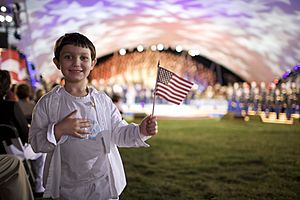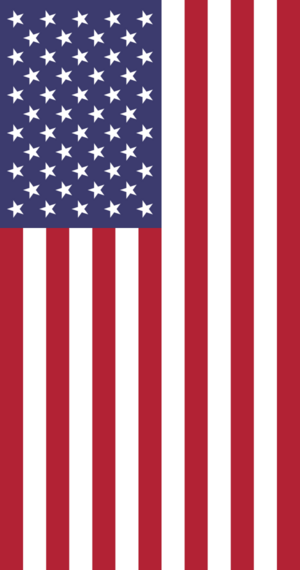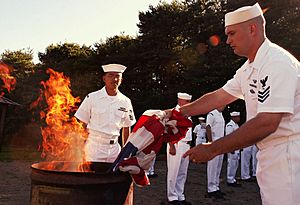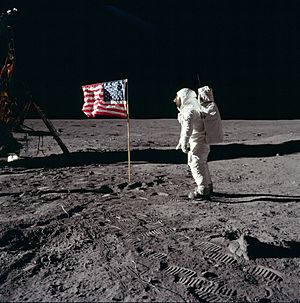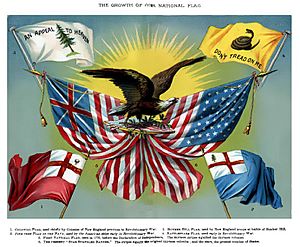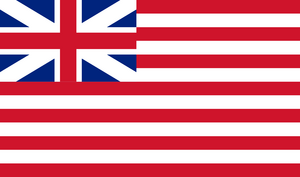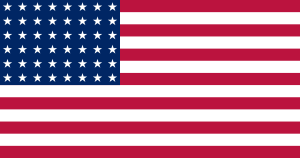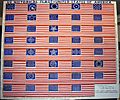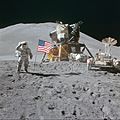Flag of the United States facts for kids
 |
|
| Names | The American flag,
|
|---|---|
| Use | National flag and ensign |
| Proportion | 10:19 |
| Adopted |
|
| Design | Thirteen horizontal stripes alternating red and white; in the canton, 50 white stars of alternating numbers of six and five per horizontal row on a blue field |
| Designed by | Robert G. Heft (50-star version) |
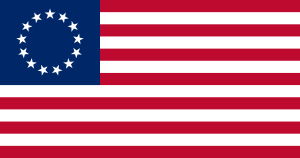
The flag of the United States of America is a very important national symbol. It stands for the freedom and unity of the United States.
The flag has seven red stripes and six white stripes. These 13 stripes represent the original thirteen colonies that formed the United States. The flag also has a blue rectangle in the top left corner. This blue part is called the canton. It has one white star for every state in the country.
When a new state joins the United States, a new flag is made with an extra star. This new flag is first flown on Independence Day, also known as the "Fourth of July."
The most recent states to join were Alaska and Hawaii in 1959. The 49-star flag for Alaska was first flown on July 4, 1959. Because Hawaii joined later, the flag with 50 stars was first flown on July 4, 1960.
The colors of the flag are red, white, and blue. Red stands for bravery and strength. White represents purity and innocence. Blue symbolizes watchfulness, never giving up, and fairness.
People often call the flag the Stars and Stripes, the Star-Spangled Banner, or Old Glory. The national song of the United States, "The Star-Spangled Banner," is named after the flag.
Contents
What Does the Flag Look Like?
- The flag has 13 stripes that go from side to side (horizontal). Seven are red, and six are white. They stand for the first 13 states.
- There are 50 white stars on a blue rectangle in the top-left corner. This blue part is called the canton. The 50 stars represent the 50 U.S. states we have today.
How the Flag is Used and Shown
The flag is usually flown all year at most public buildings. Many homes also display full-size flags. Some people fly a flag every day, but more often, flags are flown on special holidays. These include Memorial Day, Veterans Day, Presidents' Day, Flag Day, and Independence Day.
On Memorial Day, small flags are often placed at war memorials and on the graves of U.S. war veterans. It is also common to fly the flag at half-staff until noon on this day. This is done to remember those who died fighting in U.S. wars.
Flag Rules and Manners
The United States Flag Code gives rules for how to use, display, and get rid of the flag. For example, the flag should never be lowered to salute any person or thing.
The flag should never touch the ground. If it is flown at night, it must be lit up. If the edges become torn, the flag should be fixed or replaced. When a flag is too old or damaged to be a good symbol, it should be destroyed in a respectful way, usually by burning it.
The Flag Code also says the flag should not be used for advertising. It also says it should not be put on clothes or other items that might be thrown away. However, these rules are often not followed.
Another rule that is often broken at sports events is that the flag should never be carried flat or horizontally. It should always be carried high and freely.
Even though the Flag Code is a U.S. federal law, there is no punishment for regular people or groups who don't follow it. This is because forcing people to follow it would go against the First Amendment right to freedom of speech.
Flags on Vehicles and Uniforms
When the flag is on a vehicle, like a car, boat, or plane, the blue part with stars (canton) should be towards the front. This makes it look like the flag is blowing backward as the vehicle moves forward.
The flag has been on every U.S. spacecraft made for human flight, including Mercury, Gemini, and the Space Shuttle. It was also on the rockets used for Apollo missions. However, the "streaming" rule couldn't be followed in space because rockets launch and land straight up and down.
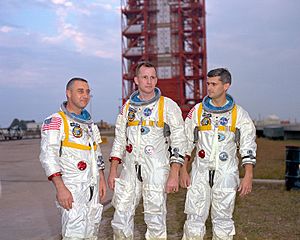

On some U.S. military uniforms, flag patches are worn on the right shoulder. The blue part with stars faces forward. This tradition comes from old army units where a soldier carried the flag into battle. As he moved forward, the flag would stream backward, with the stars staying closer to his right shoulder. Some military uniforms, like flight suits, have the flag patch on the left shoulder.
Other groups, like the Boy Scouts of America, wear flag patches too. Their rules say their uniforms should not copy military ones. So, their flags are on the right shoulder, but the stripes face forward, which is the opposite of the military style. Law enforcement officers often wear a small flag patch on a shoulder or above a shirt pocket.
Every U.S. astronaut since the crew of Gemini 4 has worn the flag on the left shoulder of their space suit. The only exception was the crew of Apollo 1, who wore their flags on the right shoulder.
Flag in Museums
In 1907, Eben Appleton loaned the famous Star-Spangled Banner Flag to the Smithsonian Institution. This is the flag that inspired the national anthem. In 1912, he made it a gift, wanting it to always be seen by the public.
In 1994, the National Museum of American History decided the flag needed special care to keep it safe for display. In 1998, museum experts carefully moved the flag to a new area for its preservation. Since 2008, the flag has been shown in a special exhibit. It rests at a slight angle in dim light to help it last longer.
Places Where the Flag Always Flies
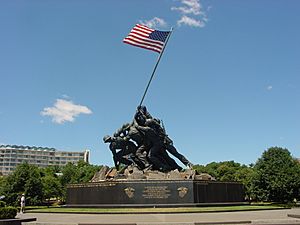
The U.S. flag is always displayed at certain places by presidential orders, laws, or tradition. Some of these places include:
- The Marine Corps War Memorial in Arlington, Virginia.
- The Lexington Battle Green in Lexington, Massachusetts, where the first shots of the Revolution were fired.
- The White House in Washington, D.C.
- U.S. Customs and Border Protection Ports of Entry that are always open.
- The grounds of the National Memorial Arch in Valley Forge NHP, Pennsylvania.
- By tradition, at the home, birthplace, and grave of Francis Scott Key in Maryland.
- At the United States Capitol building since 1918.
- At Newark Liberty International Airport and Boston Logan Airport to remember the events of September 11, 2001.
- At the ceremonial South Pole as one of the flags representing countries of the Antarctic Treaty.
- Replicas of the Star-Spangled Banner Flag (15 stars, 15 stripes) fly at Fort McHenry National Monument and Flag House Square in Baltimore, Maryland.
- Fifty U.S. flags are continuously displayed at the Washington Monument in Washington, D.C.
- On the Moon: Six manned missions successfully landed there, and each raised a flag.
Special Days to Display the Flag
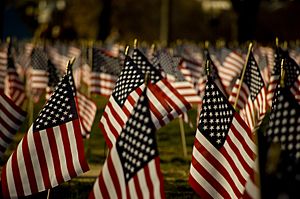
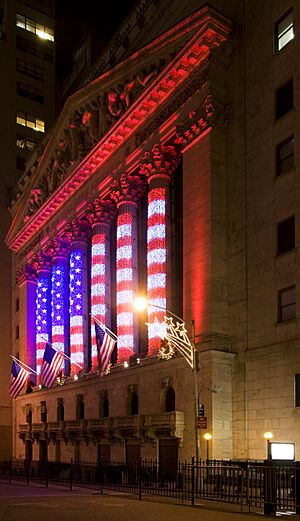
The flag should especially be displayed on these days:
- January: 1 (New Year's Day), third Monday (Martin Luther King Jr. Day), and 20 (Inauguration Day - every four years).
- February: 12 (Lincoln's birthday) and the third Monday (Presidents' Day).
- March–April: Easter Sunday (date changes).
- May: Second Sunday (Mother's Day), third Saturday (Armed Forces Day), and last Monday (Memorial Day; half-staff until noon).
- June: 14 (Flag Day), third Sunday (Fathers Day).
- July: 4 (Independence Day) and 27 (National Korean War Veterans Armistice Day).
- September: First Monday (Labor Day), 11 (Patriot Day), 17 (Constitution Day), and last Sunday (Gold Star Mother's Day).
- October: Second Monday (Columbus Day) and 27 (Navy Day).
- November: 11 (Veterans Day) and fourth Thursday (Thanksgiving Day).
- December: 25 (Christmas Day).
- Also on other days announced by the President, on the birthdays of states, and on state holidays.
History of the Flag
The U.S. flag has been changed 26 times since it was first adopted by the 13 states. The 48-star flag was used for 47 years. This was the longest time a flag design stayed the same until the current 50-star flag broke that record on July 4, 2007. The 50-star flag became official on July 4, 1960, after Hawaii became a state.
The First Flags
When the Declaration of Independence was signed on July 4, 1776, the United States didn't have an official national flag. The Grand Union Flag is often called the "First National Flag." Even though it was never officially recognized, George Washington used it during the American Revolutionary War. Its design was the basis for the first official U.S. flag.
No one is completely sure where the design came from. One idea is that it might be based on the British East India Company flag. Another idea is that it came from George Washington's family coat-of-arms. It was most likely based on a flag used by the Sons of Liberty, which had 13 red and white stripes.
Who Designed the First Flag?
Francis Hopkinson from New Jersey claimed he designed a flag in 1777. He was a naval flag designer and signed the Declaration of Independence. He said he designed it for the U.S. Navy. Records show he sent bills to Congress for his work.
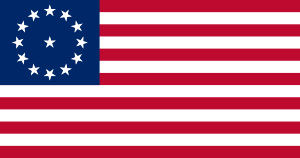
Hopkinson's story is different from the popular legend of the Betsy Ross flag. This legend says that Betsy Ross, who ran an upholstery business, sewed the first Stars and Stripes flag in 1776 at the government's request. However, Ross's grandson later admitted he couldn't find any official proof for his grandmother's story.
The family of Rebecca Young also claimed she sewed the first flag. Her daughter, Mary Pickersgill, later made the famous Star-Spangled Banner Flag. A 13-year-old African American girl named Grace Wisher helped her.
The Flag Resolution of 1777
On June 14, 1777, the Second Continental Congress passed the Flag Resolution. It stated: "Resolved, that the flag of the United States be thirteen stripes, alternate red and white; that the union be thirteen stars, white in a blue field, representing a new Constellation." This is why Flag Day is celebrated every year on June 14.
Later Flag Changes
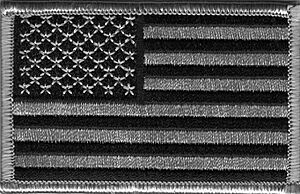
In 1795, the number of stars and stripes was increased from 13 to 15. This was because Vermont and Kentucky joined as new states. For a while, the flag wasn't changed when more states were added, probably to avoid making it too crowded. It was this 15-star, 15-stripe flag that inspired Francis Scott Key to write "The Star-Spangled Banner," which is now the national anthem.
On April 4, 1818, Congress passed a plan suggested by U.S. Naval Captain Samuel C. Reid. The flag was changed to have 20 stars, and a new star would be added for each new state. The number of stripes would stay at 13 to honor the original colonies. This law said that new flag designs would become official on the first July 4 after new states were added. The most recent change, from 49 stars to 50, happened in 1960 after Hawaii became a state in August 1959. Before that, Alaska joining in January 1959 led to a short-lived 49-star flag.
As of July 4, 2007, the 50-star flag has been in use longer than any other design.
How the Flag Designs Changed Over Time
The U.S. flag has had 28 different designs. Before 1912, there was no official rule for how the stars should be arranged on the blue part of the flag. The exact colors of the flag were not set until 1934.
Here are some of the different flag designs throughout history:
| No. of Stars |
No. of Stripes |
Design | States Represented by New Stars |
Dates in Use | Duration |
|---|---|---|---|---|---|
| 0 | 13 |  |
N/A | December 3, 1775–June 14, 1777 | 1 year (18 months) |
| 13 | 13 |  |
Delaware, Pennsylvania, New Jersey, Georgia, Connecticut, Massachusetts, Maryland, South Carolina, New Hampshire, Virginia, New York, North Carolina, Rhode Island |
June 14, 1777–May 1, 1795 | 18 years (215 months) |
| 15 | 15 |  |
Kentucky, Vermont | May 1, 1795–July 3, 1818 | 23 years (278 months) |
| 20 | 13 |  |
Indiana, Louisiana, Mississippi, Ohio, Tennessee |
July 4, 1818–July 3, 1819 | 1 year (12 months) |
| 21 | 13 |  |
Illinois | July 4, 1819–July 3, 1820 | 1 year (12 months) |
| 23 | 13 |  |
Alabama, Maine | July 4, 1820–July 3, 1822 | 2 years (24 months) |
| 24 | 13 |  |
Missouri | July 4, 1822–July 3, 1836 | 14 years (168 months) |
| 25 | 13 |  |
Arkansas | July 4, 1836–July 3, 1837 | 1 year (12 months) |
| 26 | 13 |  |
Michigan | July 4, 1837–July 3, 1845 | 8 years (96 months) |
| 27 | 13 |  |
Florida | July 4, 1845–July 3, 1846 | 1 year (12 months) |
| 28 | 13 |  |
Texas | July 4, 1846–July 3, 1847 | 1 year (12 months) |
| 29 | 13 |  |
Iowa | July 4, 1847–July 3, 1848 | 1 year (12 months) |
| 30 | 13 |  |
Wisconsin | July 4, 1848–July 3, 1851 | 3 years (36 months) |
| 31 | 13 |  |
California | July 4, 1851–July 3, 1858 | 7 years (84 months) |
| 32 | 13 |  |
Minnesota | July 4, 1858–July 3, 1859 | 1 year (12 months) |
| 33 | 13 |  |
Oregon | July 4, 1859–July 3, 1861 | 2 years (24 months) |
| 34 | 13 |  |
Kansas | July 4, 1861–July 3, 1863 | 2 years (24 months) |
| 35 | 13 |  |
West Virginia | July 4, 1863–July 3, 1865 | 2 years (24 months) |
| 36 | 13 |  |
Nevada | July 4, 1865–July 3, 1867 | 2 years (24 months) |
| 37 | 13 |  |
Nebraska | July 4, 1867–July 3, 1877 | 10 years (120 months) |
| 38 | 13 |  |
Colorado | July 4, 1877–July 3, 1890 | 13 years (156 months) |
| 43 | 13 |  |
Idaho, Montana, North Dakota, South Dakota, Washington |
July 4, 1890–July 3, 1891 | 1 year (12 months) |
| 44 | 13 |  |
Wyoming | July 4, 1891–July 3, 1896 | 5 years (60 months) |
| 45 | 13 |  |
Utah | July 4, 1896–July 3, 1908 | 12 years (144 months) |
| 46 | 13 |  |
Oklahoma | July 4, 1908–July 3, 1912 | 4 years (48 months) |
| 48 | 13 |  |
Arizona, New Mexico | July 4, 1912–July 3, 1959 | 47 years (564 months) |
| 49 | 13 |  |
Alaska | July 4, 1959–July 3, 1960 | 1 year (12 months) |
| 50 | 13 |  |
Hawaii | July 4, 1960–present | 65 years (785 months) |
Fun Facts About the U.S. Flag
- The flag has been changed 27 times. Each change happened when a new state joined the United States.
- The current 50-star flag was designed by a 17-year-old high school student named Robert G. Heft. President Dwight D. Eisenhower chose his design from 1,500 entries!
- A vexillologist is a person who studies flags.
- The flag should only be displayed from sunrise to sunset. If it's flown at night, it must be "properly illuminated" (lit up).
- The flag should be flown at or near school buildings on school days.
- When you view the flag, you should face it and place your right hand over your heart.
- The flag should be raised quickly but lowered slowly.
- The military folds the flag with 13 special folds, and each fold has a symbolic meaning.
- If the flag is flown upside down, it is a signal of distress or extreme danger.
- After a national tragedy, the flag is flown at half-staff for 30 days.
- If more than one flag is on a flagpole, the United States flag should always be at the very top.
- Francis Scott Key, who wrote the U.S. national anthem, saw the flag flying high over Fort McHenry during a British attack. Even with rockets and bombs bursting, the flag did not fall.
Images for kids
-
Our Banner in the Sky (1861) by Frederic Edwin Church
-
An American flag now flies over Gate 17 of Terminal A at Newark Liberty International Airport in Newark, New Jersey, departure gate of United Airlines Flight 93 on 9/11.
-
An American flag on the U.S. embassy in Warsaw during a German air raid in September 1939
-
The NASA Vehicle Assembly Building in 1977. The VAB has the largest U.S. flag ever used on a building.
-
Gravestones at Arlington National Cemetery decorated with U.S. flags on Memorial Day.
See Also
 In Spanish: Bandera de los Estados Unidos para niños
In Spanish: Bandera de los Estados Unidos para niños


